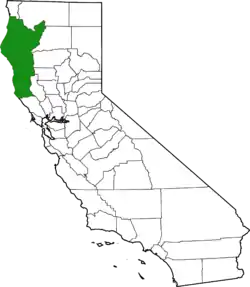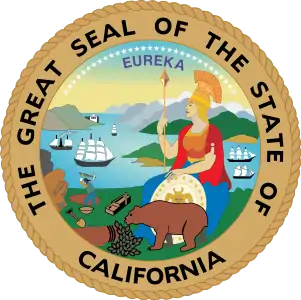Emerald Triangle
The Emerald Triangle is a region in Northern California, named as such due to it being the largest cannabis-producing region in the United States. The region includes three counties in an upside-down triangular configuration:
- Humboldt County, on the coast
- Trinity County, inland
- Mendocino County, to the south
Emerald Triangle | |
|---|---|
Region of California | |
 Map of the Emerald Triangle | |
| Coordinates: 40.0°N 123.5°W | |
| Country | United States |
| State | California |
| Counties | Mendocino County, Humboldt County, Trinity County |
| Largest city | Eureka |
| Area | |
| • Land | 10,253.58 sq mi (26,556.7 km2) |
| Population | |
| • Total | 236,250 |
| • Estimate (2019)[2] | 234,592 |
| • Density | 23/sq mi (9/km2) |
Growers have been cultivating Cannabis plants in this region since the 1960s, during San Francisco's Summer of Love. Growing cannabis in the Emerald Triangle is considered a way of life, and the locals believe that everyone living in this region is either directly or indirectly reliant on the cannabis industry.[3] The industry exploded in the region with the passage of California Proposition 215, which legalized the use of cannabis for medicinal purposes in California.[4] The passage of Proposition 64 in 2016 legalized the general sale and distribution of cannabis.
History
When growing cannabis was illegal, this area was remote with limited law enforcement. The area has developed a reputation for cannabis with exceptionally good flavor and cannabinoid profiles.[5]
Population
The total population in the Emerald Triangle is 236,250 according to the 2010 census.[6] The majority of the population is widely spread throughout the woody hills and mountains that make up the area. With an area of 11,138 square miles, the Emerald Triangle population density is 21/mi2.
In this sparsely populated region, the largest urban area is the city of Eureka in Humboldt County with a population approaching 50,000 people. The second and third largest cities, by far larger than any other cities in the region, are Arcata (also in Humboldt), with 17,231 people, and Ukiah (in Mendocino), with 16,075 people.[3][7]
Environmental concerns
There is an environmental impact from outdoor cannabis production in the Emerald Triangle, which is largely unregulated. These effects include illegal damming, diversion and taking of water from streams (especially during summer), and also pesticide-laden runoff into streams, all of which may degrade critical salmon fisheries.[8][9] Clearcutting and roadbuilding for the cannabis plantations can also degrade the environment and endanger salmon.[10] The grows often occur illegally on public land.[11][12]
Surveillance lawsuit
In 1984, Humboldt residents filed a federal lawsuit claiming they had been subject to illegal surveillance by U-2 high-altitude reconnaissance aircraft deployed by the California-based multiagency task force started the year prior, the Campaign Against Marijuana Planting.[13]
In popular culture
The Murder Mountain television series examines the high rate of missing people and murders in Humboldt County. The show covers the history of illegal marijuana farming including the relationship of local farmers and local authorities as the area attempts to transition into a legal cannabis industry.[14]
References
- "Annual Estimates of the Resident Population: April 1, 2010 to July 1, 2016 Estimates". Retrieved April 27, 2017.
- "Population and Housing Unit Estimates". Retrieved December 3, 2019.
- Ferran, Lee (August 3, 2010). "Legal Pot: Death of the Emerald Triangle?". ABC News.
- Regan, Trish (January 22, 2009). "Pot growers thrive in Northern California". CNBC.
- Roberts, Chris (September 10, 2020). "Why No Cash Crop Is More Vulnerable To California Wildfires Than Cannabis". Forbes. Retrieved 2020-09-12.
- "The Emerald Triangle: Ground Zero for Marijuana". Medical Marijuana Blog. April 8, 2010.
- Mahar, Josh (November 26, 2007). "Cascadian Communities: The Emerald Triangle". Cascadia Rising (blog).
- Glenda Anderson (June 26, 2015), "Pot raids uncover "egregious" environmental damage in Emerald Triangle", The Press Democrat, Santa Rosa, California
- Jeff Barnard (October 1, 2014), Biologists: Marijuana industry a threat to salmon, Associated Press – via Spokesman-Review
- "Black-Market Marijuana Farming Is Far From Green", Science Friday, July 31, 2015
- Josh Harkinson (March–April 2014), "The Landscape-Scarring, Energy-Sucking, Wildlife-Killing Reality of Pot Farming: This is your wilderness on drugs", Mother Jones
- Peter Fimrite (May 27, 2016), "Allure of legal weed is fueling land rush in Emerald Triangle", San Francisco Chronicle,
Environmental damage from pot farming has been a major problem for decades. Drug traffickers growing illegally, often on public land, use pesticides and fertilizers that have poisoned wildlife, including endangered spotted owls and Pacific fishers. Growers have clear-cut trees, removed native vegetation, diverted streams, [and] caused erosion
- Carole Rafferty (June 10, 1984), "Marijuana raids angering retirees", The New York Times
- Schou, Nick (February 8, 2019). "Sweet Streams: Into the Emerald Triangle's Murder Mountain". OC Weekly. Retrieved 2020-10-01.

